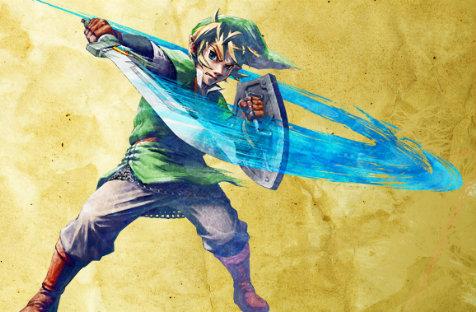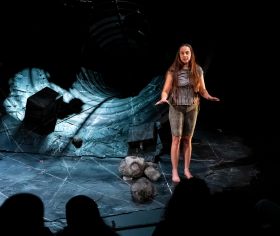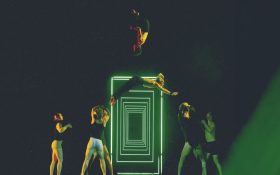Does anyone actually bother to read the signs outside various concert venues? All those unheeded warnings and prohibitions against taking photographs, or having mobile phones operating during the music, and so on. (As a side note, I always find it amusing that one of the pre-concert announcers for the Sydney Symphony refers to them as ‘mobile telephones’, but I’m weird that way.)
Cut to the Sydney Symphony’s first concert of the year (not including their 2001: A Space Odyssey orchestra-as-soundtrack divertissement), The Legend of Zelda: Symphony of the Goddesses. The scene: the main stairway leading up from the Sydney Opera House mezzanine to the Concert Hall. Plunked in the middle of this aforementioned staircase is a sign perched atop a metal pole (the kind of pole used to rope off areas), which says – and I quote this exactly – ‘All swords, shields, spears and other weapons must be left in the cloakroom during the performance’.
Now, lack of Oxford comma aside, this to me was perhaps the most interesting piece of audience-direction I’ve ever seen. (One assumes that after the many light sabres waved around during the Sydney Symphony’s John Williams concert last year (Williams being the composer of soundtracks to such films as Raiders of the Lost Ark and Star Wars), someone thought they better put a stop to such blatant war-mongering from the crowd.)
The Legend of Zelda is a long-running series of computer games designed by Nintendo, and one of the most popular game franchises of all time. As such, many a nerd’s heart (including this geek’s circulatory hub) has been captured by Link (the game’s protagonist) and his quest to save Princess Zelda, and a nerd enamoured is a nerd likely to dress as their favourite character (‘cosplay’ is the term). It happened at the Williams concert – many a flowing Jedi robe was to be seen – but I failed to notice any prominent cosplaying going on at the performance I attended, although many people were wearing one of the Zelda T-Shirts on sale in the foyer. But better safe than sorry, I suppose, lest some patron disappointed with a lack of encores rushes the stage with shield and sword and takes the conductor hostage. Or poke someone’s eye out. (Probably the more likely scenario.)
(As yet another side note: where would the cloakroom staff store the swords – the umbrella stand, perhaps?)
The format for the evening was a tad more complex than one might have expected. Conductor Eimear Noone would sometimes speak to the audience between pieces, and sometimes not, but if she didn’t then she would introduce (and reintroduce) Jeron Moore, one of the producers of the concert. Moore was an interesting fellow, who seemed to have a very American attitude toward talking to an audience (if you watch David Letterman’s late night show, you’ll know what I mean). This manifested itself in quite a few series of slightly awkward pauses as Moore gave us a bit of information and then duly waited for our response (which he seemed to expect to be riotous applause or uncontrollable laughter). A lot of the time the response was fairly small (or non-existent) yet Moore would roll on as if nothing had happened. (Which, indeed, it had.) Mentions of semi-obscure references to different parts of the games elicited quasi-enthusiasm from the crowd. Indeed, one feels the concert would have been rather more streamlined if his role had been streamlined into the conductor’s. (Perhaps his spiel would have worked in another country, but it felt strained here.)
There was also a large screen behind the orchestra, on which were projected images of the games interspersed with close-ups and panning shots of the different sections of the orchestra itself. The footage of the game was much like that seen in the recent Pixar concerts, with montage upon montage of key moments, as well as plenty of fighting.
And so we began with the Overture, which was a lovely little medley of many of the game’s most famous themes. A collection of Dungeons came next, followed by Kakariko Village – Hope and Calm, then Songs of the Hero. The playing, by the orchestra and Cantillation, was perfectly fine throughout the evening, with Noone bringing out more than one might have expected from the music.
The symphony came next, or the first two movements (plus a prelude) of it. After the first movement, Noone turned around to tell the audience that ‘it isn’t customary to stop between movements in a symphony,’ but that she had a special reason for doing so. Moments later she revealed that she had a ‘Wind Waker’ – a crucial baton used in The Legend of Zelda: The Wind Waker – to conduct the second movement with. (This was well received by the crowd.) And then there was the interval. And then Fairy Fountain, which was a delightfully charming development on the restful theme heard at the fairy fountains in the game. And then the symphony continued. (So much for not stopping between movements.)
The symphony – billed as the first video game symphony ever – was enjoyable enough, though one can’t help but wonder if that is because of my pre-existing love for the franchise, as opposed to true musical merit. However, there was much more complexity to it than most video game music, so one cannot complain too much.
After the symphony (and therefore the end of the concert) came three encores, the first containing music from Link’s Awakening (for the original Game Boy), the second containing music from Gerudo’s Valley (from The Legend of Zelda: Ocarina of Time, one of the greatest games of all time), and the third containing music from Majora’s Mask (from the game of the same name). One’s money’s worth was had by all, one imagines.
Rating: 4 stars out of 5
The Legend of Zelda: Symphony of the Goddesses
Sydney Symphony
Cantillation, Eimear Noone (conductor)
Overture
Dungeons
Kakariko Village – Hope and Calm
Songs of the Hero
Symphony
Fairy Fountain
Sydney Opera House Concert Hall
2 February





